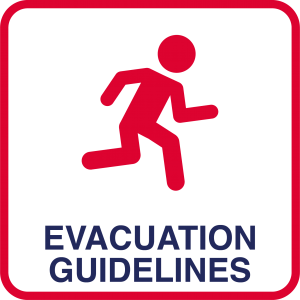Many different types of emergencies may occur here at the College, such as fire, power failure, tornado warnings, hazardous material spills, earthquakes, and many more. While the College lists procedures you should take in each of those scenarios, you may initially be unsure whether to evacuate or shelter in place.
Despite what emergency that may occur, knowing when to evacuate and shelter can help you though most emergencies on campus.
Evacuate
Evacuation means to leave the space where you are presently located because something potential dangerous is occurring. An alarm or alert may instruct you to evacuate a building, an area, or the entire campus. Examples of situations where you may need to evacuate are: fire or suspected fire, hazardous material spill, after an earthquake, extended power outage, and as instructed by authorities.
When there is an order to evacuate the building or a fire alarm is sounding:
- Immediately stop what you are doing. Remain calm.
- If time, conditions and safety permit, take important personal items with you (i.e. car keys, purse, medication, glasses, etc.). Leave everything else and close the door behind you.
- Walk directly to the nearest exit. Always know at least two exits out of a building in case one is obstructed. Move quickly; however, do not run, push or crowd.
- If smoke is present, stay low and crawl to your exit. Do NOT use elevators. Do NOT open a hot door.
- Once outside, move quickly away from the building and to an Assembly Area, unless otherwise instructed. Follow directions from College Police, wardens, and first responders.
Shelter
For some emergencies, evacuating the building can put you at greater risk than staying put. In these situations, you should shelter in place. Examples of situations where you may need to shelter are: tornado warning, exterior hazardous materials, severe weather or flooding, and as instructed by authorities.
In general, when there’s an order to shelter in place:
- Go immediately to:
- The nearest Severe Weather Shelter Area
OR - An appropriate area that will provide protection – harden structure, interior rooms or hallways, areas free of windows or glass, at the lowest level possible in the building
- The nearest Severe Weather Shelter Area
- Go to the center of the room, away from corners, doors and outside walls.
- If possible, get under a sturdy table. Use your arms to protect your head and neck. Protect your body from flying debris with any available furniture or sturdy equipment.
- Wait for an “all clear” to exit the room or building.
Some emergencies (such as active shooter and bomb threats) are dependent on the situation and may include both evacuation and shelter orders. It is strongly recommended you read the College Emergency Action Plan (EAP) to become familiar with detailed emergency procedures for different scenarios that will require you to evacuate or shelter. The EAP can be found at: https://www.nvcc.edu/emergency/plan.html.

